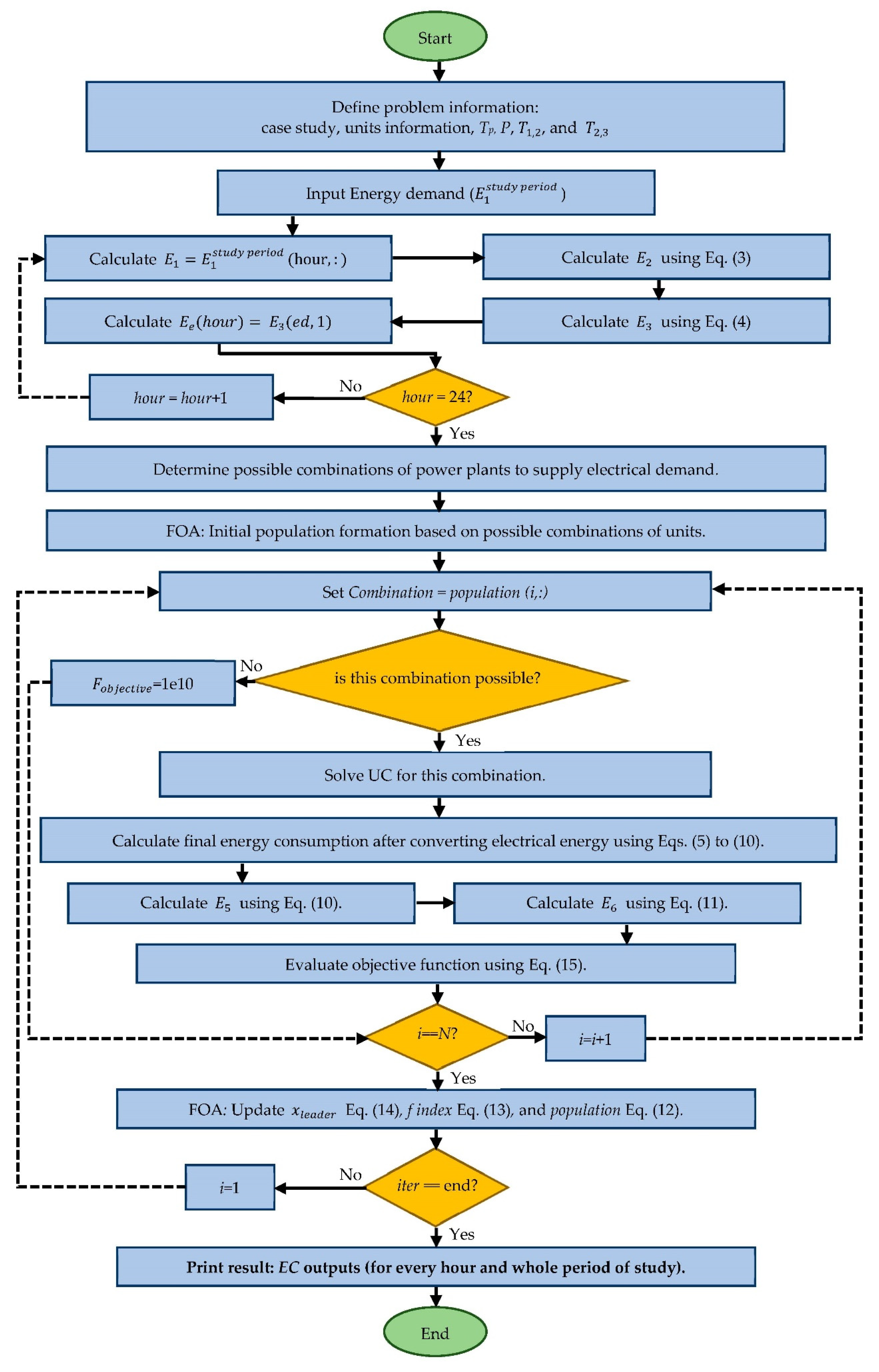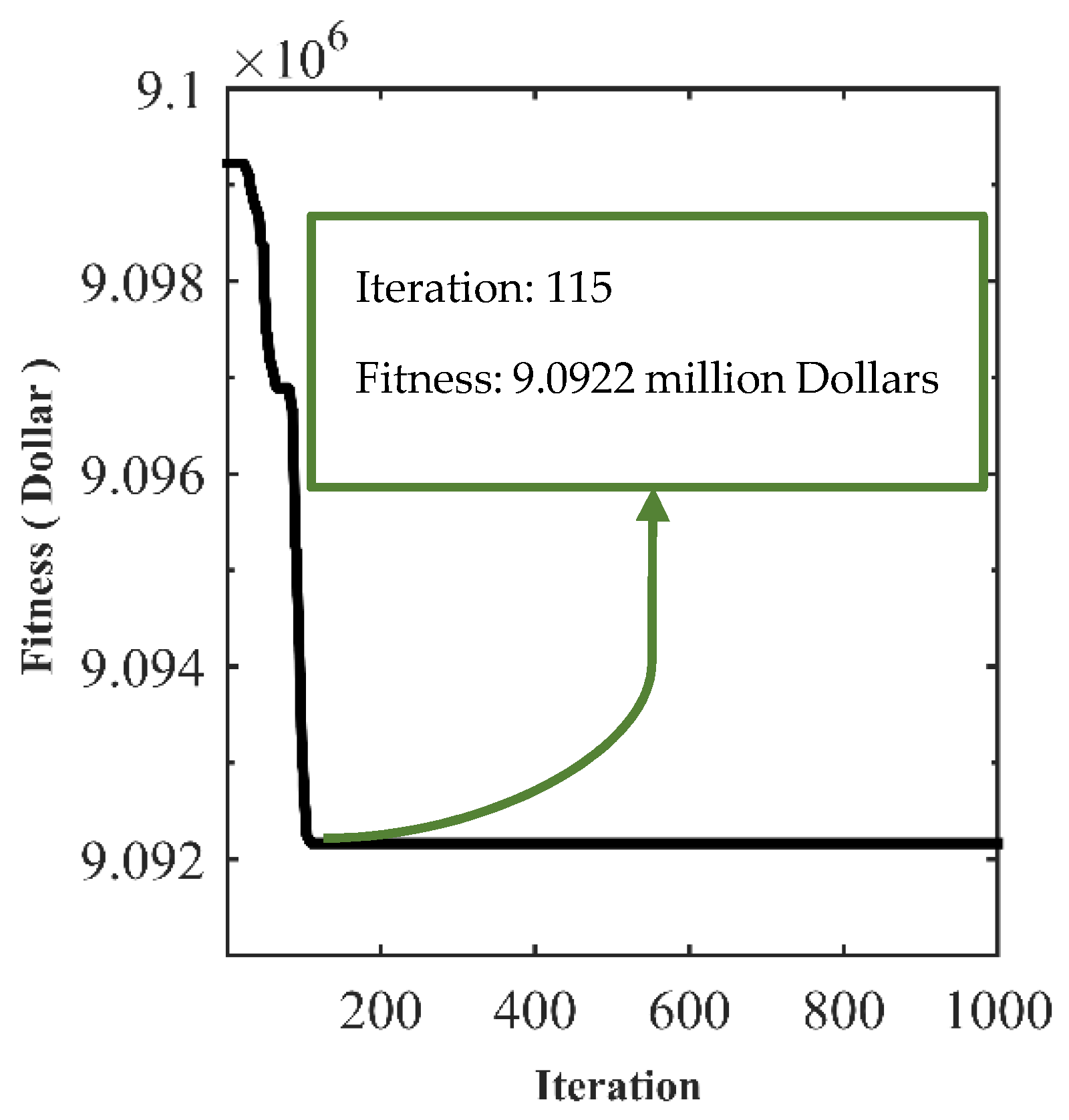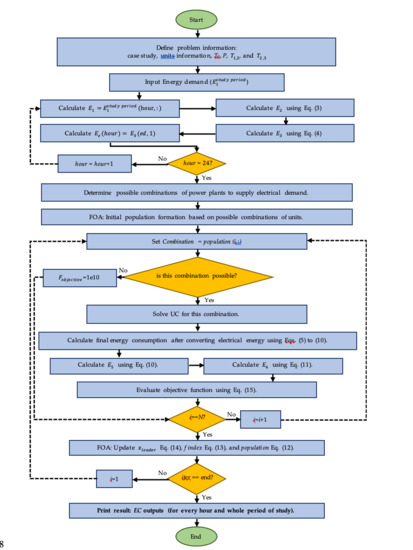1. Introduction
An energy carrier is a substance—for example, fuel, or sometimes a phenomenon (energy system)—that contains energy, which can be later converted to other forms, such as mechanical work or heat, or operate chemical or physical processes. Today’s societies use several energy carriers in the industry, service, residential, and transportation sectors. Among the various energy carriers, oil is of paramount importance, since its price has a considerable effect on economic growth. Besides, neither oil nor any of the fossil fuels such as coal and natural gas have endless sources. The growing demand on the one hand and declining fossil resources, on the other hand, necessitate full consideration for the operation of energy. Therefore, the operation of energy carriers to supply the energy demand, called the Energy Commitment (EC) problem, is studied, in particular from the perspective of an electric power system.
Unit Commitment (UC) is a significant study carried out in the operation of the electricity grid. An essential criterion in UC is the supply of power demand with the least fuel cost and optimal combination of different power plants [
1]. It forms the basis of energy carrier commitment.
The UC issue has been of great interest to researchers as evident from the following representative literature. In [
2], uncertainty in the production of virtual power plants is investigated, and transmission line constraints in solving the UC problem for large-scale networks are studied in [
3]. The UC problem in the presence of Flexible AC Transmission System (FACTS) devices and energy storage devices is investigated in [
4]. To solve the UC problem, a novel annual analysis is proposed for the thermal power generator and pumped storages under a massive introduction of renewable energy sources [
5]. Ref. [
6], the authors proposed the implementation of the UC in the presence of energy storage systems and its optimal size for a region in northern Chile. Solving the UC problem in the presence of wind, nuclear, and thermal power plants has been studied by considering the security constraints of the transmission line and the influence of wind power uncertainty on the spinning reserve capacity of the system in China [
7]. A new method based on the Particle Swarm Optimization (PSO) algorithm, [
8], and the solution of the UC problem using genetic algorithm was proposed in [
9]. Other algorithms, such as the Gray Wolf Optimizer (GWO) [
10], Whale Optimization Algorithm (WOA) [
11], simulated annealing [
12], and shuffled frog-leaping algorithm [
13] have also been suggested to find the solution to the UC problem.
In recent years, Multi-Carrier Energy (MCE) systems that improve energy efficiency and reliability have received much attention. Each of the gas, electrical, and heat networks consists of energy sources, several loads, and a set of transmission lines or pipes that supply energy demand through the resources of the system. The flow value of the supply lines of each of these grids can be calculated mathematically by the quantities of those lines [
14].
A mathematical model for intelligent loads participation in load response programs in an MCE system management is proposed, [
15]. In this model, the optimal operation is performed using an energy storage system. The effects of load response programs on the efficiency and operating costs of MCE systems in the presence and absence of wind energy and energy storage are evaluated and analyzed in [
16]. The teaching and learning-based optimization algorithm is applied to optimize the operation of MCE systems in [
17].
In general, an Energy Hub (EH) is an interface between the production, consumption, and transmission of different forms of energy. EHs are connected to electric power grids and perform energy conversion operations from one state to another or improve the quality of energy delivered to the load. Thus, the inputs of an EH consist of different forms of energy, and its outputs are system loads. The purpose of the EH is to provide the required energy for load demand through its input and internal equipment [
18].
The concept of EH has been introduced in various residential, commercial, and other applications. In this regard, economy and energy savings in a hospital have been studied [
19], and linear integer programming is presented to improve the performance of an electric micro-grid in the presence of cooling, thermal, and electrical loads [
20]. The optimal operation of a residential house as an EH using the PSO algorithm is proposed in [
21]. The optimal operation of an EH has been studied considering the energy storage systems in [
22]. The EH has also been proposed for economic and reliability purposes in [
23] with the aim of proper selection of the internal EH equipment. Furthermore, the energy management of smart hubs is discussed in [
24].
As mentioned in the previous subsections, in UC, the goal is to determine the appropriate pattern of power plant production to supply the electrical demand. In an MCE system, gas, electrical, and heat networks are examined, and the purpose of the EH is to supply the required energy demand through its input and internal equipment. Although very valuable studies have been conducted by researchers in the operation of power systems, the operation of an integrated grid called the energy grid and determining the appropriate pattern of use of energy carriers to supply energy demand in this network has been less studied. Therefore, a new study named the Energy Commitment (EC) problem that determines a suitable pattern of energy carriers utilization to supply the energy demand in particular from the perspective of an electric power system is proposed. In the proposed EC study, more details of the network such as the simulation of oil refining and the impact of the imports and exports of energy carriers are considered.
The EC problem in a multi-carrier energy system is proposed to be studied using the Following Optimization Algorithm (FOA). Therefore, the optimal operation of energy carriers can be obtained. The proposed study aims to realize the following:
Mathematical modeling and formulation for an EC problem.
Objective function is considered as minimizing energy supply costs for the total study period.
The FOA is used to solve the EC problem, which is a constrained optimization problem.
Study the technical aspect of supply energy demand in various sections (with different types of energy carriers).
Applying the proposed study to a standard energy grid that includes different sectors of energy consumption (transportation, agriculture, industrial, residential, commercial, and public).
Studying the simulation of refinery and oil-refining process.
Studying the impact of import and export of energy carriers on EC.
Determining the appropriate pattern for the use of energy carriers to supply energy demand, considering technical and economic constraints.
Increasing the awareness of the importance of an EC study to enhance the operation of energy systems.
The introduction and background of the topic are presented in
Section 1. The problem definition and problem formulation are described, respectively, in
Section 2 and
Section 3. Application of the proposed study is investigated and discussed in
Section 4, while the conclusions are presented in
Section 5.
2. Problem Definition
2.1. Energy Commitment
Researchers have provided valuable studies on energy and energy management [
25,
26,
27,
28,
29]. A significant issue in energy studies is the operation of energy carriers. The primary energy carriers are those that are directly extracted from natural sources such as crude oil, hard coal, and natural gas. All carriers of energy, not primary but produced from primary energy, are called secondary energy carriers [
30].
Table 1 shows an overview of renewable versus non-renewable energy and primary versus secondary energy.
Researchers over time have conducted wide research into the operation of power systems and power supply to consumers. In the unit commitment study, the on or off status of the units and the optimal production of each unit are determined for a specific period of study based on the predicted electric demand. Although resolving the UC provides valuable information, dependencies between energy carriers are not considered.
Therefore, the following can be mentioned:
The UC focuses solely on the study of the electrical grid and the supply of electrical demand.
In the UC, only the forecast of electricity demand is available.
Independent optimization of energy networks does not necessarily lead to the optimization of the entire energy network.
In the UC, possible substitutions between energy carriers are not considered.
The study of EC is introduced with the attitude of operation of energy carriers in an integrated energy network, considering the possibility of possible substitutions between energy carriers. In the proposed EC study, instead of forecasting electricity consumption, forecasting energy demand for other energy carriers is also available, and based on this, the optimal operation of energy carriers is presented simultaneously.
EC determines the most appropriate pattern of using energy carriers wherein first technical problems and then economic issues are adequately addressed. If the energy carriers are used according to the peak demand, it will cost a lot. In fact, energy carriers should be optimally utilized, as managing energy resources properly can save a considerable amount of money. In the EC issue, first, the energy demand (actually the energy demand curve) must be determined. This energy demand curve, similar to the UC problem, can be a 24-h curve. In the UC problem, for every hour of the study, there is an electricity demand that must be met by the appropriate combination of units. However, in the EC, for every hour of the study, there is an energy demand of different types, including electricity, gas, car fuel, aircraft fuel, etc., which must be met using the appropriate combination of energy carriers.
2.2. Energy Grid
The EC study should be done in a proper space called the energy grid. The various sectors of the proposed energy grid are transportation, agriculture, industrial, residential, commercial, and public sectors.
In the energy grid, the energy demand is calculated as the sum of the demand in the various subdivisions of the grid using (1):
where
is the total energy demand,
is the energy demand of the
i-th sector of the grid, and
is the number of different sectors of the energy grid.
The primary constraint on the EC problem is to supply the total energy demand. The energy consumption in different parts is (2):
where
is the energy demand matrix in the various energy sectors. This energy demand can include a variety of energy carriers such as natural gas, electricity, coal, etc. For the energy grid proposed, the energy demand is considered to be as below:
3. Problem Formulation
Energy network matrix modeling is presented. This modeling is performed in several steps, from the lowest energy level (final energy consumption) to the highest energy level (primary energy carriers).
Final energy consumption based on different energy carriers is specified as:
where
is the final energy consumption based on different energy carriers and
is the transform matrix of different sectors to different energy carriers. The values of
are determined based on the simulation of experimental and practical data.
Energy loss is modeled using (4).
where
is the final energy consumption based on different energy carriers considering losses and
is the efficiency matrix. The values of
are determined based on the simulation of experimental and practical data.
At this stage, the electrical energy is proportioned to the energy carriers. In fact, at this point, the UC problem must be resolved. The electrical energy of different power plants is determined as shown in (5):
where
is the electrical energy of different power plants,
is the separation matrix of electricity generated by various power plants that is calculated based on solving UC, and
is the total electricity demand.
Input fuel for different power plants is determined by (6):
where
is the input fuel for different power plants and
is the power plant efficiency matrix.
The source energy carrier for electricity generation is determined using (7).
where
is the source energy carrier for electricity generation and
is the conversion matrix of input fuel to energy carriers.
After the calculation of electrical energy, the final energy consumption is calculated using (8).
where
is the final energy consumption after converting electrical energy to input carriers to units.
At this stage, the process of refining crude oil is simulated using (9).
where
represents the energy carriers produced by refining,
is the separation matrix of products created from refining crude oil, and
is the maximum capacity of refineries.
After simulation of the refining crude oil process, the final energy consumption is calculated using (10).
where
is the final energy consumption after refining crude oil. Actually,
determines the energy carriers that supply the energy demand.
Import and export of energy carriers are determined by (11):
where
P is the domestic production of energy carriers, and
is the import and/or export of energy carriers. In
, the positive sign means import and negative sign means export of energy carriers.
5. Conclusions and Future Works
Energy consumption is one of the criteria for determining the level of development and quality of life in a country. The continuity of energy supply and ensuring long-term access to resources have required a comprehensive energy plan. Energy carriers are one of the critical topics in the field of energy operation. Thus, this paper presents a methodology called Energy Commitment (EC) for the optimized operation of energy carriers using the Following Optimization Algorithm (FOA).
The goal in EC is determination of the most appropriate pattern of using energy carriers to supply energy demand considering technical and economic issues. EC is a constrained optimization problem that can be solved using various methods, especially the optimization algorithms. In this paper, the FOA algorithm has been applied to solve the EC problem.
EC has been implemented on an energy grid with 10 power plants and including different consumption sectors of transportation, agriculture, industrial, residential, commercial, and general. Important outputs and information have been obtained by the implementation of an EC study on this energy network. This information and output signify the need for different energy carriers to meet the energy demand, the optimal combination and production of units (UC and EC outputs), and the amount of imports and exports of energy carriers.
Various combinations of power plants are available to supply the electricity demand for every hour of operation. According to the different fuel inputs to each power plant, different combinations of energy carriers are obtained. The appropriate combination of power plants and proper energy combination carriers to supply the energy consumption has been determined using the FOA. The FOA has a good performance in solving the EC problem by presenting a smooth convergent curve and achieving the optimal solution in the appropriate number of iterations.
The simulation results of the proposed study on the energy grid show that the EC analyzes the energy grid more efficiently and accurately than the UC. UC only studies the electrical energy network, while the EC operates energy carriers in an integrated energy network with energy demand for different energy carriers. Therefore, UC is one of the important outputs of the EC study and in fact, UC is a subset of the EC study.
The authors suggest implementing EC on various energy networks and scenarios, as well as using other optimization techniques for future studies. Ideas for further studies and future research include the introduction of new objective functions with new constraints such as the impact of CO2 and EC solving considering the response time required by each energy storage/carrier.













